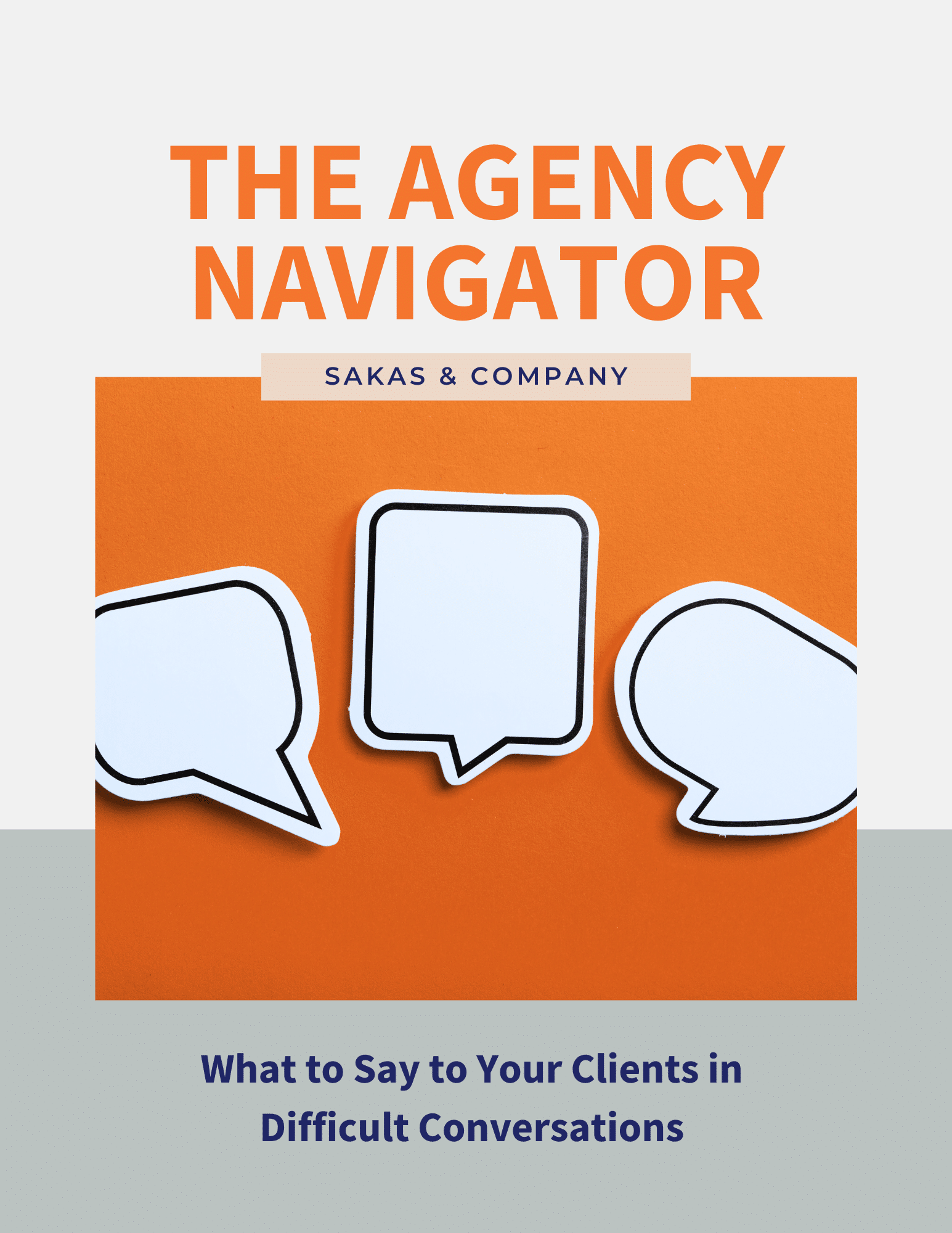Think about the best meeting you’ve had with a client… and the worst meeting. I bet your best meetings moved the relationship forward. And the worst meetings? You might’ve moved backward.
- Good client meetings are energizing—you helped the client accomplish their business goals, or you moved the engagement forward, or you grew the relationship, or all of those at once.
- Bad client meetings are draining—you didn’t accomplish anything positive, or the engagement’s stuck, or the client’s unhappy, or all of those at once.
Having lots of good client meetings? It’s a sign that things are running smoothly. Lots of bad meetings are a sign you might have a problem… or perhaps several.
Fortunately, you can create better client meetings by building three key components into every meeting—whether virtual or in-person:
1. Always have an agenda, even if it’s an informal agenda.
2. Always send a prompt post-meeting recap, including a summary of decisions and each person’s actionables.
3. Always send followups about those actionables, to ensure that people make progress.
Can you occasionally break these rules? Sure—sometimes meetings are “get to know you” relationship-building, and you won’t do a formal agenda or recap. (But still consider an informal agenda—even if it’s just a mental bullet point about something you want to share or ask.)
Let’s look at why client meetings are important to your agency, and then take a closer look at each of the three “rules.”
Why Client Meetings Are Important (Even if They’re Virtual)
Client meetings are important, but for a reason you might not expect—meetings are where you cement the value your agency delivers. There’s a reason prospect- and client-facing meetings are a big source of drama in Mad Men—they’re high stakes.
Your usual weekly or biweekly or monthly status meeting is lower stakes, but it’s important to the client—they can sense if your agency isn’t treating their meeting as important.
It might be one of five meetings that day for the agency account manager—but to the client, it might be their most important meeting (for their job… or at least for the work your agency is doing for their business).
To recap, client-facing meetings—and thus the relationship as a whole—lose value without 3 key components: an agenda, a post-meeting recap (including decisions and actionables), and followups to hold the client (and internal team) accountable on the actionables.
Now, let’s take a closer look at each of those three—including my tips to make things easier for you!
Rule #1: Have an agenda.
Know what you want to discuss, and share the agenda with everyone beforehand. This helps people prepare for the meeting, instead of making things a surprise.
When people are unprepared, they’re wasting others’ time. If you called the meeting, it’s your job to help people come prepared.
You may need to get input from others on your team—you want to avoid negative surprises. As lawyers joke: “Never ask a question where you don’t already know the answer.”
You may also need to get input from the client, too. In a high-profile client meeting (e.g., it’s normally just the CMO, but this time the CEO’s joining), send an early draft agenda to your contact so they can help you avoid any landmines that make them (or you) look bad.
I start every client meeting by asking: “What would make today’s conversation a success for you?” (WWMTCAS). At the end of the meeting, I confirm whether we’ve met those WWMTCAS goals. (Answer: “Yes” nearly 100% of the time, because I intentionally manage the meeting to ensure we meet their goals.)
Rule #2: Send a [prompt] post-meeting recap.
The ideal recap includes a summary of decisions and actionables, including an “owner” and deadline for each actionable.
Why? The decision recap means there’s [usually] no question later about what the client decided, and about who needed to do what after the meeting.
When more than one person has actionables, I split the full actionable list into sub-sections, so that each person has their “own” actionables list. This creates a little extra work for me, but it makes it easier for the client—it’s part of my creating a boutique client experience, by putting myself in the client’s shoes. (It’s not their job to “parse” the multi-person list.)
How should you send the recap? I maintain a Google Doc agenda for each client meeting, with an actionables list at the bottom, and then I email a recap of the actionables. (I record decisions in my agenda’s super-detailed meeting notes.) If you use a PM system (please do!), you should load (or at least log) the recap there.
How soon should you send the post-meeting recap? Soon! I email a copy of the actionables after each call (immediately, or within one business day). The longer you wait, the less relevant it becomes.
What if your agency needs to check the internal schedule before promising a timeline? That’s smart expectations management. In that case, give the client an ETA on when you’ll share the timeline. (If you’ll have a deadline promise within a day or two, it may make sense to delay the recap until the deadline is ready—but don’t wait too long!)
Tip: Block-in time on your calendar after each client meeting to send the recaps. I like a 30-minute buffer, since it helps me cover the inevitable other items, too. Or if you have back-to-back meetings that day, reserve time at the end of the day for the inevitable followups; they won’t magically happen if there’s no time.
Rule #3: Follow up on actionables.
It’s not enough to share the actionables—you need to follow up to ensure they happened.
After my monthly Executive Coaching calls, I use Boomerang to “bounce-back” my email recap, so I can ask clients about their initial progress. I also use my PM system to assign internal tasks, as applicable.
Wait—do post-meeting followups “count” as part of the meeting itself? From my experience as an agency PM, I certainly think so! They might happen later, but the followups are vital. Put another way—followups help make the meeting worth it, by continuing the momentum.
In contrast, have you ever had what seemed like had a great client meeting at the time… but then things petered out? Perhaps your clients didn’t care as much as you did. But more often, your client cared but got distracted by their day-to-day challenges.
Your followups help keep a client’s previously-stated priority (what you discussed in the meeting) front and center in their busy day.
How often should you follow up? It depends on the nature of your client relationship. In coaching, clients set monthly goals (toward their long-term strategic priorities). Accountability is part of coaching—my job is to follow up.
Definitely use an email scheduling tool to stay on top of this. I like Boomerang for Gmail; there are built-in Gmail features, too. If you use Apple Mail, try MailButler. If you use Outlook, there’s Boomerang for Outlook.
Do you have to use an email scheduling tool to stay on top of post-meeting followups? Nope—you’re welcome to use your PM software or a task manager instead, but I like having something that lets me get reminders that are “close” to my followup action—in this case, sending an email ping.
What about internal actionables for your own team? Use your regular PM process to stay on top of that, including assigning things out and managing deadlines and other commitments. (This is all billable!)
Bonus: Customize by Meeting Type
Want to make your meetings even better? Customize your agenda based on the specific goal of each meeting type.
When I mentioned I was writing about better client meetings, fellow AMA leader and B2B marketing consultant Alexandria Trusov shared a tool she created to manage attendees’ expectations. She has three types of meeting topics, color-coded.
Green = Explore — “This is the brainstorming part everyone loves!”
Yellow = Evaluate — “This is when your team evaluates ways to make whatever is on the agenda happen. (An alternative to evaluate is ‘Enhance,’ where the team thinks about ways to improve the idea under discussion.)”
Red = Execute — “This is where your team gets laser focused on what it takes to get whatever is on the agenda or docket done.”
Nice, right? An individual meeting can have multiple topic types—and you can color-code the sections so people know whether it’s an “Explore,” “Evaluate” (or “Enhance”), or “Execute” situation.
Get her one-page template here, and you can reach Alexandria directly at TruInsights Consulting.
Taking Action: Creating Better Client Meetings at Your Agency
Think about ways to add the three things—agenda, recap, and followup—to your agency’s account management process. And think about how you can enlist your team to help.
Sometimes your recap might be a single sentence in an email (e.g., “I’ll ask Sally to send you the XYZ report”), and sometimes you’ll skip the formal agenda (e.g., for a relationship-building lunch).
The key is to be intentional about how to handle client meetings, and what you expect your account managers and project managers to do on your behalf.
If you follow my article’s advice on a consistent basis, I predict better client meetings in your future—which just might extend to better client retention, higher employee morale, and higher agency profits.
Get My Templates to Jumpstart Your Progress
Wish you could draw on agency best practices to improve your client meetings, whether they’re virtual or in-person? Get my continuously-updated Agency Profitability Toolkit™!
The library’s ~60 templates, SOPs, and other tools include 14 account management templates, including four about client meetings:
- Pre-Kickoff Survey (use this to prepare for the relationship’s most important meeting)
- Kickoff Meeting Agenda (use this to start happier, more profitable relationships)
- Client On-Site Agenda (use this to help clients make the most of your visit)
- Client On-Site Price Calculator (use this to calculate what to charge a client when you visit, including hard and/or soft costs)
You can get immediate access to all ~60 agency templates for as little as $97/month—get instant access here.
Question: How do you create better client meetings at your agency?


